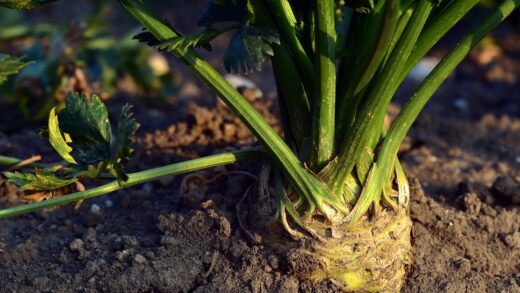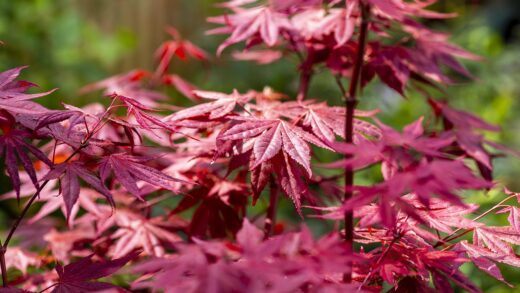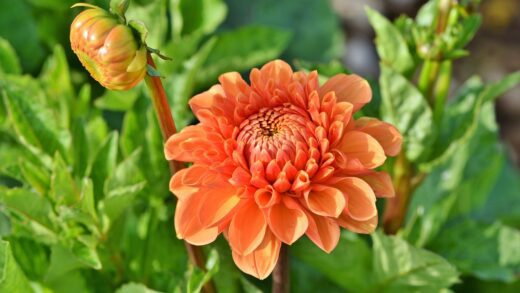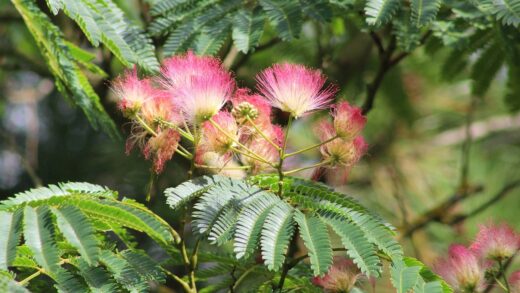Providing the appropriate nutrition is essential for cultivating a pineapple sage that is not only healthy and lush but also produces the abundant, fragrant leaves and spectacular late-season flowers for which it is prized. While this plant is not an excessively heavy feeder, its vigorous growth throughout the spring and summer does require a steady supply of essential nutrients from the soil. A well-balanced diet supports all of the plant’s metabolic functions, from photosynthesis and foliage production to root development and, ultimately, flowering. Neglecting its nutritional needs can result in a plant that is stunted, pale, and fails to reach its full potential, whereas a proper fertilization strategy will be rewarded with a robust and vibrant specimen.
The foundation of good nutrition for pineapple sage begins not with a fertilizer bottle, but with the soil itself. Before planting, enriching the garden bed with a generous amount of high-quality organic matter is the most beneficial step you can take. Incorporating materials such as well-rotted compost, aged manure, or leaf mold creates a fertile and biologically active soil environment. These organic amendments act as a slow-release fertilizer, providing a broad spectrum of macro- and micronutrients over the entire growing season. They also dramatically improve soil structure, enhancing both drainage and moisture retention, which is critical for this particular plant.
When supplemental fertilization is needed, the key is to aim for balance. A fertilizer that is excessively high in nitrogen will stimulate rapid, lush foliage growth, but this often comes at the direct expense of flower production. The plant will expend all its energy on creating leaves and stems, resulting in a large, green, but ultimately flowerless plant come autumn. Therefore, the ideal choice is a balanced, all-purpose fertilizer where the N-P-K (Nitrogen-Phosphorus-Potassium) numbers are relatively even, such as a 10-10-10 formula. Phosphorus is particularly important for promoting strong root development and encouraging flower production.
The timing and frequency of fertilizer application are just as important as the type of fertilizer used. Begin feeding in the spring, once new growth is well underway, to support the plant as it builds its leafy framework. A regular feeding schedule, perhaps every four to six weeks with a diluted liquid fertilizer or once with a slow-release granular product, is typically sufficient throughout the summer. However, it is critically important to cease all fertilization by the end of summer or early autumn. This signals to the plant to halt its vegetative growth and shift its resources toward the all-important process of budding and flowering, which is triggered by the shortening days.
The nutritional profile of pineapple sage
Pineapple sage, like all plants, requires a suite of essential nutrients to carry out its life processes, which are broadly categorized into macronutrients and micronutrients. The primary macronutrients—Nitrogen (N), Phosphorus (P), and Potassium (K)—are needed in the largest quantities. Nitrogen is the fundamental building block for chlorophyll and proteins, making it essential for vigorous leaf and stem growth. This is why a nitrogen-rich diet leads to a very leafy plant. Phosphorus plays a critical role in energy transfer, root development, and the process of flowering and fruiting. Potassium is vital for overall plant health, regulating water movement, and enhancing resistance to stress and disease.
While N, P, and K are the headliners, the secondary macronutrients—calcium, magnesium, and sulfur—are also required in significant amounts. Calcium is crucial for building strong cell walls, which contribute to the plant’s structural integrity. Magnesium is a central component of the chlorophyll molecule, without which photosynthesis cannot occur. Sulfur is a key component of certain amino acids and vitamins. A deficiency in any of these can lead to specific symptoms, such as stunted growth or discoloration of the leaves, even if the primary macronutrients are plentiful.
In addition to macronutrients, pineapple sage also needs a range of micronutrients, which are required in much smaller quantities but are no less essential for the plant’s health. These include iron, manganese, zinc, copper, boron, and molybdenum. These elements often act as co-factors for enzymes, enabling critical biochemical reactions to take place within the plant. For example, iron is essential for chlorophyll synthesis, and its deficiency often leads to chlorosis, where the leaves turn yellow, but the veins remain green. A healthy, biologically active soil rich in organic matter will typically provide all the necessary micronutrients.
Understanding this nutritional profile helps to inform a sensible fertilization strategy. The goal is not to flood the plant with a single nutrient but to provide a balanced diet that meets all its needs. Using a complete fertilizer that contains a range of micronutrients is often a good choice, especially for plants grown in containers where the soil volume is limited and can become depleted over time. For garden-grown plants, relying on compost and other organic matter is often the best way to ensure a full spectrum of nutrients is available in a natural, slow-release form that the plant can readily absorb.
Choosing the right fertilizer
Selecting the appropriate fertilizer for your pineapple sage is a critical decision that directly influences its growth pattern and flowering success. The choice between synthetic and organic fertilizers is often the first consideration. Synthetic, or chemical, fertilizers are formulated to provide nutrients in a form that is immediately available to the plant, which can result in a quick growth response. They are often sold as liquids, water-soluble powders, or granular products with a specific N-P-K ratio clearly labeled. While effective, they do little to improve the long-term health of the soil and can be applied too heavily if one is not careful, potentially burning the plant’s roots.
Organic fertilizers, on the other hand, are derived from natural materials such as compost, bone meal, blood meal, and kelp. These products release their nutrients more slowly, as they need to be broken down by soil microorganisms before they become available to the plant. This slow-release nature provides a more gentle, sustained feeding and greatly reduces the risk of fertilizer burn. Furthermore, organic fertilizers contribute to the overall health of the soil, improving its structure and feeding the beneficial microbial life within it. For the long-term vitality of both the plant and the garden, an organic approach is often superior.
When looking at the N-P-K ratio on a fertilizer package, aim for a balanced formula for most of the season. A 10-10-10 or a 5-5-5 fertilizer provides equal amounts of the three main macronutrients, supporting all aspects of the plant’s growth. As the season progresses towards autumn, you could theoretically switch to a “bloom booster” formula, which has a higher phosphorus number (the middle number) to specifically encourage flowering. However, a simpler and often equally effective approach is to simply stop fertilizing altogether, which naturally encourages the plant to shift its focus from growth to flowering.
For container-grown pineapple sage, the choice of fertilizer is particularly important, as the plant is entirely dependent on you for its nutrition. A liquid fertilizer is often the easiest to apply and control in a pot. You can use a balanced liquid feed, diluted to half the recommended strength, every few weeks during the growing season. Alternatively, you can mix a granular slow-release fertilizer into the potting mix at the time of planting. This will provide a steady baseline of nutrition for several months, after which you may only need to supplement with liquid feed occasionally if the plant shows signs of needing a boost.
The fertilization schedule throughout the year
A well-structured fertilization schedule for pineapple sage aligns with its natural growth cycle throughout the year. The process begins in the spring, but not necessarily at the first sign of life. It is best to wait until the plant has produced a few inches of strong, new growth before applying the first dose of fertilizer. This ensures that the root system is active and ready to absorb the nutrients. A single application of a granular, slow-release balanced fertilizer at this time can often provide a solid foundation of nutrients that will last for the next few months.
As the plant moves into the summer, its period of most vigorous vegetative growth, its nutritional demands are at their highest. If you are using a liquid fertilizer, this is the time to apply it on a regular schedule, typically every four to six weeks. This consistent supply of nutrients will fuel the rapid production of the stems and fragrant leaves. Always water the plant thoroughly before applying liquid fertilizer to avoid burning the roots. If you applied a slow-release fertilizer in the spring, it may be starting to deplete by mid-summer, and a supplemental dose of liquid feed can provide a welcome boost.
The most critical point in the fertilization schedule occurs in late summer to early autumn. At this juncture, all fertilization must cease. Continuing to feed the plant, especially with nitrogen, will encourage it to keep producing new leaves, which will delay or even prevent the onset of flowering. The plant needs an environmental signal to switch from growth mode to reproductive mode. The shortening daylight hours are the primary trigger, but a halt in the nutrient supply reinforces this message, telling the plant that the season of abundance is ending and it is time to produce flowers and seeds.
For plants that are being overwintered, either in the ground in mild climates or in pots indoors, no fertilizer should be given during the winter months. The plant will be dormant or in a state of very slow growth, and its nutritional needs are practically zero. Fertilizing a dormant plant is not only wasteful but can be harmful, as the unused nutrient salts can build up in the soil and damage the inactive root system. You should only resume feeding in the following spring, once again waiting for active new growth to appear as the sign to begin the cycle anew.
Identifying and correcting nutrient deficiencies
While a good soil preparation and a sensible fertilization plan should prevent most problems, it is still useful to be able to recognize the signs of specific nutrient deficiencies in your pineapple sage. A nitrogen deficiency is one of the most common issues and is characterized by a general yellowing (chlorosis) of the foliage, starting with the older, lower leaves. Growth will also be weak and stunted. The solution is straightforward: apply a nitrogen-rich fertilizer, such as a balanced liquid feed or a top dressing of compost or aged manure, to provide a quick boost.
A phosphorus deficiency, while less common, can manifest as stunted growth and leaves that take on a dull, dark green or even purplish hue. Since phosphorus is vital for flowering, a deficiency can also be a reason for a lack of blooms, even if the plant appears otherwise leafy and green. To correct this, you can use a fertilizer with a higher middle number (P), such as a bloom booster formula, or amend the soil with organic sources of phosphorus like bone meal or rock phosphate. This is best done earlier in the season to support root growth and prepare the plant for flowering.
Potassium deficiency often appears as a yellowing or browning along the edges or margins of the older leaves, while the center of the leaf remains green. The plant may also have weak stems and a general lack of vigor, as potassium is crucial for overall plant health and stress resistance. Organic sources of potassium include kelp meal and greensand. A balanced synthetic fertilizer will also contain sufficient potassium to correct the issue. Ensuring the soil pH is in the appropriate range (around 6.0 to 7.0) is also important, as an improper pH can “lock up” nutrients in the soil, making them unavailable to the plant even if they are present.
Deficiencies in micronutrients like iron or magnesium can also cause leaf chlorosis. An iron deficiency typically causes the new, younger leaves to turn yellow while the veins stay green, a condition known as interveinal chlorosis. A magnesium deficiency looks similar but tends to appear on the older, lower leaves first. These issues are more common in high pH (alkaline) soils or in container plants where the soil has become depleted. A chelated iron supplement can correct an iron deficiency, while a dose of Epsom salts (magnesium sulfate) dissolved in water is an effective remedy for a lack of magnesium.




















